Extract from The Guardian
Katharine Murphy
The Labor leader has the zeitgeist on
his side but he still has to convince voters angry enough to vote for
Pauline Hanson

Contact author
Tuesday
31 January 2017 18.24 AEDT
At
the opening of the political year in Canberra, one thing is
striking. Malcolm
Turnbull has the pinched look of a leader braced for a siege
that could be either long or short, and Bill Shorten looks like he’s
on a pleasant summer stroll.
Shorten
dimpled at the podium at the National Press Club in Canberra while
delivering a year-opening speech that had a simple message: I am you,
I get you, I know precisely what you are worried about (your own job,
jobs for your kids, slow wages growth, house prices, the health
system).
The
empathy offensive contained some hooks designed to make disaffected
voters look up, high up in the speech, so you wouldn’t miss them if
you ducked out during the live broadcast to water the plants.
To
address the widely held perception that politicians have their snouts
more or less permanently in the trough, there were some (reheated)
integrity measures (after a summer of expenses scandals) and positive
noises on a national integrity commission (although not a concrete
commitment – let’s not get rash, people, please).
There
was also a mea culpa of sorts, an acknowledgement that “politics as
usual doesn’t cut it”.
The
Labor leader reasoned politics was intrinsically about conflict, and
a contest of ideas, but politics also had to lower the volume
sufficiently to be able to listen to the voters.
Shorten
didn’t say it in a way direct enough to be stinging to the
journalists, who listened without looking, which is what we always do
on these occasions, checking a written text against delivery,
scribbling in the margins.
He
pitched his message at low enough volume not to troll the scribbling
scribes and spoke directly to the people at home.
Shorten
said politicians needed to bust out of the yoke of the Canberra press
conference and the tyranny of the eight-second news grab and get back
into town halls where there was more latitude to chat, explain and
engage.
In
such settings, Australians could pose questions and, just as
importantly, posit answers. Politics, Shorten said, needed to embrace
the art of active listening.
So,
to summarise, Shorten and his speechwriting team looked out into the
mildly terrifying and endlessly fracturing political landscape of
January 2017 and concluded that politics had to be personal.
“Otherwise
we risk creating a vacuum, a marketplace for extreme views and for
prejudice.”
He’s
absolutely right of course.
Both
in temper and in content, Shorten has begun the political year
absolutely on the zeitgeist, hence that brimming confidence.
Labor
is talking about the issues that people are concerned about, in a way
they can actually connect with.
But
Shorten is not a diagnostic physician, abstractly plotting the
ailments of the body politic, he’s a protagonist and a participant.
He’s the person who is going to have to deliver the style of
politics he’s championing.
If
politics is about people, and about connections, Shorten’s
challenge for 2017 is not only validating the concerns of voters
angry enough to propel Donald Trump to the White House, to Brexit and
to vote for Pauline
Hanson – but to persuade them to make a durable connection
with him.
He’s
got to persuade them that he’s prime ministerial material. And he’s
got to instil confidence in his colleagues that he’s the leader who
can ultimately close the deal and get Labor back into power.
Shorten
has to be the leader who can galvanise the base but not be its
creature. He has to hold the party’s progressive flank (under
pressure from the Greens) and its working-class flank (being courted
aggressively by the nostalgia merchants of One Nation) – and speak
compellingly to the swinging voters – at a time when voters are
looking for alternatives to the major parties.
If
politics is in the grip of an epic disruption, if major party
politics in Australia is in structural decline, if there is a
resurgence of populism, the big question facing the Labor leader at
the beginning of 2017 is: will the times suit him?
Shorten
looks like a politician with the belief that he’s found his moment,
which is a more than useful starting point. But the field evidence
suggests voters, thus far, are not convinced.
The
Labor leader managed to get in front of Tony Abbott on one crude and
incomplete yet still pertinent measure – Newspoll’s preferred
prime minister rating – but he has not yet managed to pull in front
of Turnbull.
The
closest gap between the combatants has been nine points. Given where
Turnbull is at politically, that tells you something.
It
tells you there’s a hesitation factor. It tells you the Labor
leader has a job of work to do.
And
while much about politics in 2017 is uncertain, we can guarantee the
vocation remains, ruthlessly, a performance-oriented business.
The
ALP will not want to emerge from the current electoral cycle as the
party that chose the wrong leader at the wrong moment in political
history.
Just
ask the US Democrats what that feels like.
No comments:
Post a Comment